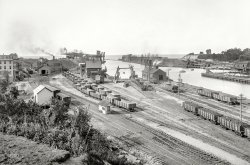
MAY CONTAIN NUTS

Search Shorpy
SHORPY ART

Framed or unframed, desk size to sofa size, printed by us in Arizona and Alabama since 2007. Explore now.
Join and Share
Ad-Free Shorpy
Shorpy is funded by you. Patreon contributors get an ad-free experience.
Learn more.

Recent comments
- Details, Details
- What's that building to the left of the tower?
- Coal Barges
- Bromo-Seltzer
- Inner harbor
- The Basin
- What a headache!
- Giant stepladder?
- Baldwin 62303
- Baldwin VO-1000
- Cold
- No expense spared
- Tough Guys
- Lost in Toyland
- And without gloves
- If I were a blindfolded time traveler
- Smoke Consumer Also Cooks
- Oh that stove!
- Possibly still there?
- What?!?
- $100 Reward
- Freeze Frame
- Texas Flyer wanted
- Just a Year Too Soon
- WWII -- Replacing men with women at the railroad crossing.
- Yes, Icing
- You kids drive me nuts!
- NOT An Easy Job
- I wonder
- Just add window boxes
Member Photos
The Shorpy
Print Emporium
Print Emporium
Search Shorpy
Search results -- 30 results per page
- The Launch: 1912
- November 9, 1912. Wyandotte, Michigan. "Steamer Seeandbee , the launch." Thrilling denouement of the ... into an aircraft carrier for training pilots on Lake Michigan during WWII. She was cut up in 1947. Google U.S.S. Wolverine.
(The ... Posted by Dave - 08/09/2012 - 3:18pm -
![The Launch: 1912 November 9, 1912. Wyandotte, Michigan. "Steamer Seeandbee, the launch." Thrilling denouement of the scene glimpsed earlier here. 8x10 inch dry plate glass negative, Detroit Publishing Company. View full size.
Murder weapons!Those hat pins the ladies are sporting could easily be used for knitting, trussing the turkey or—Heavens to Betsy—homicide!
I do hope the chaps got out in time I remember seeing quite a few people standing right where that ship is making a splash.
E ticket?I think those people on the boat had the most fun.
Got your backWhat a great image! I would like to thank the photographer for such an interesting viewpoint. The spectators watching the event so intently make the picture, rather than get in the way, and are as interesting a subject as the launching of the ship. They help to place the event in history. I wonder if he (or her) felt this at the time? Or that this was the only place they could set up their camera. I suspect the latter, but all the same, a wonderful image. I'm going to remember this next time I'm taking photos and thinking that the crowds are getting in the way of my shot.
Business opportunityWhat a great moment in time it would have been for an enterprising pickpocket! I'm surprised that the photographer hasn't captured one.
Side wheelerAs I see from the other shot, this ship was a side wheeler. I'm very curious why designers as late as 1911 would choose to make a ship a paddle wheeler, rather than a screw propeller driven craft. There must have been advantages.
GraffitiIs that an early form of graffiti on the platform the people are standing on?
[It's a railroad car, which frequently bore handwritten markings by RR yardmen, though usually in chalk. And graffiti dates back to ancient times.]
Became USS Wolverine in March 1942.This ship was taken over by the navy in 1942 and turned into an aircraft carrier for training pilots on Lake Michigan during WWII. She was cut up in 1947. Google U.S.S. Wolverine.
(The Gallery, Boats & Bridges, DPC)](https://www.shorpy.com/files/images/SHORPY_4a16222a.thumbnail.jpg)
- New Wave: 1941
- July 1941. "Detroit, Michigan. Women drying their hair in the beauty shop at the Crowley-Milner ... Posted by Dave - 01/08/2013 - 6:27pm -
![New Wave: 1941 July 1941. "Detroit, Michigan. Women drying their hair in the beauty shop at the Crowley-Milner department store." Under the Helene Curtis Express. Large-format negative by Arthur Siegel, Office of War Information. View full size.
On track for a promotionThat's George Patton on the cover!
Prymaat and ConnieI think I recognize those two women on the left. They're from France.
Helmet HairI don't know where my parents got it. But we had one of these in the basement when I was growing up in the early '60s. Used it as a space helmet/ship during playtime when Mom wasn't drying her hair.
Starr roleHard to believe this was Ringo's ambition had the Beatles' bubble burst.
EmpressIf you look closely, the label on the hair dryer reads
"Helene Curtis Empress"
The Beauty ShopThat reminds me of going with my mom to the beauty shop when I was a pre-schooler. I was awestruck by the ladies with their heads in the dryers as they chattered away amid the din of whirring dryers. I'm also reminded of the strong smell of hair spray, Dippity-Do, and whatever else hung in the air.
That's LifeEvery Crowley-Milner department store picture so far has had Life magazine in it somewhere - from the desk of the Ad man to the Mattress department, and now here, Life is the ONLY magazine on the table and the one being prominently held up for the camera. Seems the Office of War Information had a vested interest in Life.
[More likely that Crowley-Milner had a tie-in with LIFE. - tterrace]
I Remember the SmellEvery department store had a salon when I was a kid in the 50s. The thing that was really scorched into my memory was the terrible (in my view) smell of those facilities. I can only assume it was the various fluids that were used for perming and coloring the hair. Don't know how anyone could work all day in those places!
(The Gallery, Arthur Siegel, Detroit Photos, Stores & Markets)](https://www.shorpy.com/files/images/SHORPY_8d25329a.thumbnail.jpg)
- High Noon: 1909
- Circa 1909. "Marquette, Michigan. Front Street." 8x10 inch dry plate glass negative, Detroit Publishing ... Posted by Dave - 07/19/2012 - 10:26pm -
![High Noon: 1909 Circa 1909. "Marquette, Michigan. Front Street." 8x10 inch dry plate glass negative, Detroit Publishing Company. View full size.
Ware roomsPresumably ware rooms are what you find in a warehouse, in this case storing furniture.
What a difference a century makesThe picture of this town 103 years ago is full of life and interesting little moments; boys chatting, someone selling balloons (?), a man leaning on his cane with panache while another just watches the world go by, beautifully dressed women with children shopping -- a myriad of details I am fascinated by. Jump to the same spot in 2012 and ... nothing. Hard to imagine anyone doing Shorpy's wonderful job in the future because what aficionado of history would want to spend time looking a HD closeups of empty streets, cars and maybe a pedestrian or two. Bottom line, one picture is endlessly absorbing, the other totally boring. Makes you wonder about "progress."
Lunch Time at the Ice Cream ParlorIt's noon by the building clock, and the locals are mobbing the ice cream parlor.
Plus 103Between a glitch in Google Street View and the difference in the lenses, it's impossible to capture the same angle - but this is close. A nice assortment of "still standing" and "long gone." (Pedestrians and trolley cars seem to be in the latter category.)
Lots Going OnSo many questions: What's the guy selling that has the kids so interested? Why are some in uniform? Speaking of which, the man across the street (front right) appears to be in a policeman's uniform, but the hat is too informal. Also, he has a cane. Why is there a wooden platform behind him leading to a blank wall? And that kid there can't be doing what he looks like he's doing. Can he?
What kind of rooms?I wonder what kind of rooms are ________RE ROOMS? See the brickwork high on the hotel(?) on the left.
[From the panorama we later published. Now we just have to figure out what it means. - tterrace]
Wooden WallRegarding the wooden wall, that appears to be for a railroad line running underneath the street. You'll see a railroad station to your left, as well as a different street cover along this extent. I believe the wall was to keep people away from the train tracks.
From Merriam-Webster onlineware·room [noun \ˈwer-ˌrüm, -ˌru̇m\] A room in which goods are exhibited for sale. First known use: 1811.
DentistNow that is good product placement for a dentist to open up shop next door to an ice cream parlor. I wonder if he is a partner in both locations.
@jdowling23 Question"Why is there a wooden platform behind him leading to a blank wall?"
The wooden platform is actually a bridge over a set of railroad tracks that lead out to cranes for unloading coal in the Marquette Harbor. The wall is for safety as it was a 16' drop down to the tracks. See attached links for different view of Front Street and the City of Marquette around that time. You can see the same wood bridge in one and the cranes in the other. Also you can see the ore docks that gravity load iron ore into ore boats to take the iron ore to Pittsburgh. Iron mining was and still is a big business in Marquette County. The photo in question was taken standing on the a steel bridge leading to the old ore dock that can be seen in the attached photos.
https://www.shorpy.com/node/12493?size=_original#caption
https://www.shorpy.com/node/12492?size=_original#caption
(The Gallery, DPC, Small Towns, Streetcars)](https://www.shorpy.com/files/images/SHORPY_4a23258a.thumbnail.jpg)
- German American Bank: 1911
- ... Cable office below German American Bank. Possibly Detroit, Michigan." Downstairs: Lafayette Barber, offering Shower and Needle Baths, and ... Posted by Dave - 08/21/2012 - 11:20am -
![German American Bank: 1911 Circa 1911. "Postal Telegraph Cable office below German American Bank. Possibly Detroit, Michigan." Downstairs: Lafayette Barber, offering Shower and Needle Baths, and something to do with electric vibra[...]. View full size. For a closeup of the Model T, click here. For the rest of the building, see this post.
One ClueIs the street sign next to the bank entrance.
Where to get your needle bath!Looks to me to be the corner of Lafayette & Griswold, looking south. To the far left is a glimpse of City Hall & in the background is the Hammond Building. Now about that needle bath ...
Nice brass-radiator Model T FordThe driver must have had to contort himself severely to honk the horn.
Barber caught shortGreat illusion here of the basement tenant entrances looking like doorways for the Seven Dwarfs. Fantastic livery abounds here plus that barbers pole is so iconic. I assume it is electric and it turns showing a twirling red, white and blue.
Give a toot!Very serious horn mounted on the side of the roadster.
[Click to embiggen. Note the chain on the rear tire. - Dave]
1911 Torpedo RunaboutThat Model T Ford is a rare 1911 "Torpedo Runabout" from about the middle of 1911. Early models had a square gas tank which was superseded by the round one on this car. Not all that popular when they were new, they are rarely seen and treasured by collectors today. Possibly the sportiest Model T made. Most 1911 Ts were painted a very dark, almost black, blue. It would not be until the 1914 Fords that you could get any color so long as it was black. Red, green, and grey were common in the very early Model Ts.
(The Gallery, Cars, Trucks, Buses, Detroit Photos, DPC)](https://www.shorpy.com/files/images/4a26718a.thumbnail.jpg)
- The Squeaky Wheel: 1904
- Circa 1904. "Michigan Central Railroad engineer oiling up before the start." 8x10 inch dry ... Posted by Dave - 08/02/2012 - 5:26pm -
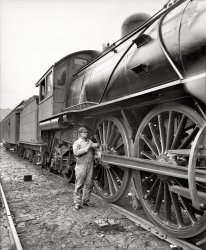
- Meanwhile, Back in Petoskey: 1900
- Petoskey, Michigan, circa 1901. "Grand Rapids & Indiana R.R. station." 8x10 inch dry ... Posted by Dave - 08/10/2012 - 12:05am -
![Meanwhile, Back in Petoskey: 1900 Petoskey, Michigan, circa 1901. "Grand Rapids & Indiana R.R. station." 8x10 inch dry plate glass negative, Detroit Publishing Company. View full size.
Always a first hereNever have seen a boat on a baggage carrier before.
Engine/TenderI'd like to see that engine and tender from the side; it appears that it's a commuter run (from the crowd on the platform) but it must run in reverse a lot because of the cow-catcher on the tender. No turn wye at either end of its run? Railfans - help?
Typical Trolley StopOk typical turn of the century trolley stop. two trolleys numerous interesting people, wait a second go back the sort of dapper guy in the foreground with the lapstrake skiff on a hand truck. Excuse me buddy but you can't take your fishing boat on the trolley even if you pay 2 fares.
I am really trying to figure this one out and just what is he doing with the boat at a trolley stop, we will probably never know.
[He's taking it (or sending it) somewhere else. This is, as noted in the caption, a railroad station, not a a trolley stop. - Dave]
Sorry Dave I was only looking at the Trolley that was probably bringing people to the train. But on another note, why is there a man sitting in the boat? is he part of the shipment?
Take a ride on the GR&IClick to embiggen.
It's a double enderIn this era about the only locomotives with big headlights on both ends were either switchers or double-enders. The catcher on the rear does indeed indicate this hog has regular assignment on a job where half of the trips are backward.
The earlier picture of Petoskey shows a train ready to leave here, probably with this very engine, running in reverse.
If you search an old GR&I timetable from this time, you'll find out where this train was going. It probably ran to some branch terminal that had no turn facilities, or it may have ended its run at some main line station that had no turn facility.
One of the most famous short line steam roads today, Pennsylvania's Strasburg Rail Road has been doing that from the start; there never have been turn facilities at Strasburg.
Next StopYou are right, the engine is designed to run tender first at the head of the train. The likely destination is Harbor Springs, which was served by a branch line diverging just north of Petoskey. Another depot photo shows a main line train on the track adjacent to the station, and a branch line train with a similar engine, tender first, on the next track. In some eras, through Pullmans were carried from Cincinnati and Chicago, dropping wealthy tourists close to their lake front hotels.
Tank EngineThe loco is a tank engine -- it has no separate tender. Both the coal bunker and water tank are carried on a rearward extension of the loco frame, in this case on a four-wheeled truck. It is a type of engine commonly but not always correctly referred to in the US as a "Forney." They were designed to be run safely at track speed in either direction without turning, making them well suited to suburban trains.
Railroad expansion plansCompare this one to the Petoskey depot view posted a few days earlier. Station platform is longer and has a new roof structure in 1908. New station platform surface. More tracks about the depot -- the expansion process is evident in this picture with rock wall stone on the flat cars. Extra track is to be added and the water spout seems to be missing in '08 shot -- as is the station semaphore signal. Engine number 4 is backing toward you in this view -- and may be the engine in the foreground in the 1908 view -- a number 4 seems to be on the forward headlight number board of the 4-4-0 in the '08 view though it is not clear. The engine cabs are a bit different -- back cab windows are at a higher level in the 'o8 photo. Rolling tail light shade is missing in this shot but evident in the '08 view.
Suburban Station at PetoskeyThis is the GR&I (later PRR) suburban station at Petoskey, which operated during the summer months for tourists headed out for the day at Walloon lake or Alanson. The steam engine pictured could operate in either direction (without turning on a wye track) to facilitate quick turnarounds. This suburban station was located about two blocks to the south from the main passenger station which still exists in 2011, without passenger train service.
"cowcatcher"?? Puleeze!!The proper term used by railroad personnel is "pilot".
The "station semaphore" is properly called "order boards" and the "water spout" was commonly called a "standpipe".
Possibly, in other parts of the world, these other terms may have been different, but "cowcather": never!
(The Gallery, DPC, Petoskey, Railroads)](https://www.shorpy.com/files/images/SHORPY_4a07903a.thumbnail.jpg)
- Chateau Crestline: 1954
- Dearborn, Michigan. "1954 Ford Crestline Fordor Sedan." With room in back for their 2.5 ... Posted by Dave - 03/22/2021 - 8:03pm -
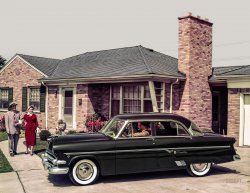
- Dodges of War: 1942
- ... the Albert Kahn designed Dodge Truck Plant in Warren Michigan, just north of Detroit. This plant, like many other Kahn designs, was ... Posted by Dave - 03/27/2013 - 11:56pm -
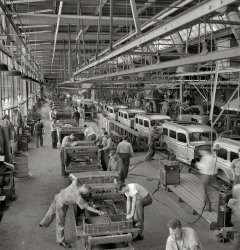
- Kar Nation: 1914
- ... a picture of a restored one. They were built 1913-1914 in Detroit, Michigan, by the American Voiturette Company.
Masonry walls The car ... Posted by Dave - 08/26/2012 - 11:45am -
![Kar Nation: 1914 Washington, D.C., circa 1914. "Kar Nation." One of four photos of this odd-looking auto taken from various angles. Harris & Ewing glass negative. View full size.
Look Ma! No DoorsNot on the street side, anyway. Nobody entered or exited there. Too many road apples and too much mud. Left side doors gained popularity later, in the mid 20's.
Was it Pink?The Car-Nation was a lightly built cyclecar produced in Detroit in 1913 and 1914. This one is the four seater tourer and would have cost $520.
Interesting in that is is very similar to the French Marlborough cyclecar (1906 t0 1926) except that the Marlborough had a rounded-front to the radiator.
Curbside AccessI'm assuming there's a door on the curbside of the car, since there doesn't appear to be one on the side facing the camera. Was it common on early cars to have no driver's side door?
Before its timeSort of the AMC Gremlin or Pontiac Aztec of the era I suppose.
Car-NationThought I remembered that as a make of car. Try Wikipedia under "Car-Nation" for a picture of a restored one. They were built 1913-1914 in Detroit, Michigan, by the American Voiturette Company.
Masonry wallsThe car appears to be parked on H Street NW just east of 13th. The building behind it is the old Masonic Temple, now the National Museum of Women in the Arts.
CanisterWhat is the canister shaped thingy on the running board?
[Acetylene gas reservoir for the headlights. - Dave]
Mass Market AttemptCycle cars were an attempt to reach the mass market by producing small, lightweight cars in a period when the majority of automobiles were large and expensive.
They were pretty much supplanted by the Ford Model T - a full size car at a mass market price. They remained a fringe market well into the '20s. The market was slightly revived by the Crosley and European microcars after WWII.
No DoorsOne reason many cars of these early times had no streetside doors was because the hand brake and various other appurtenances would have blocked them. I believe some Model T Fords sported this "feature."
[Another reason: Cheaper to build. - Dave]
Current Car-NationFound this article about a restored one.
Deep ThoughtsAlthough I prefer car designs from the 1960s on, I must say this is a great looking car. Nice clean design. Wish I had it in my garage! Every time I see a photo on Shorpy, I get confused in all sorts of time and place thoughts, difficult to grasp what it really means -- 10 years, 20 years, 50 years. Imagine hundreds of years. People then didn't think of computers as mobile phones as missing tools. They thought they were living in times of progression and they were, too. They were as comfortable in their homes as we feel now, it's all relative. Was life better then or is it better now?
(The Gallery, Cars, Trucks, Buses, D.C., Harris + Ewing)](https://www.shorpy.com/files/images/04257a.thumbnail.jpg)
- And Step on It: 1910
- ... a period of 3 months.”
In October of that year, the Michigan Labor Inspector noted that the bakery employed 3 males and 2 females, ... Posted by Dave - 05/31/2017 - 12:33pm -
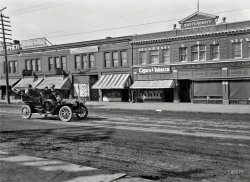
- City of Alpena: 1899
- ... and highways to the communities of booming Northeast Michigan.
The CITY OF ALPENA was taken off the ... of the towns in the region. She operated afterward on Lake Michigan as the CITY OF SAUGATUCK, and ended up in the late 1930s as a barge, ... Posted by Dave - 08/12/2016 - 3:41pm -
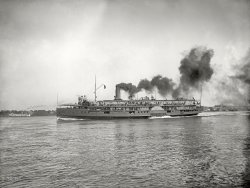
- Tourist Auto Co.: 1910
- Detroit, Michigan, circa 1910. "Tourist Auto Co. (Tourist buses in front of church with ... Posted by Dave - 08/21/2012 - 12:00pm -
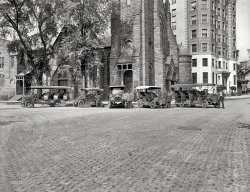
- Grant Park: 1911
- ... of the McCormick Building, at the northwest corner of Michigan Avenue and Van Buren Street, designed by Holabird & Roche and ... just about everything else you see in this view of the Michigan Avenue "Wall" is still standing.
Grant Park: 2014 As Michael R ... Posted by Dave - 08/07/2014 - 5:17pm -
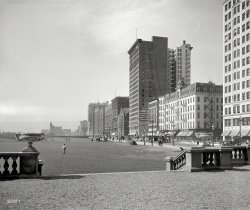
- The Casino at Belle Isle: 1907
- Detroit, Michigan, circa 1907. "New casino at Belle Isle Park." 8x10 inch dry plate ... Posted by Dave - 08/08/2012 - 2:50pm -
![The Casino at Belle Isle: 1907 Detroit, Michigan, circa 1907. "New casino at Belle Isle Park." 8x10 inch dry plate glass negative, Detroit Publishing Company. View full size.
Can you hear me now?The cellphone tower is really planning ahead.
Love the "under construction" picsI love to see how methods, materials, and tools were implemented during construction of these buildings from the past. Nary a Dewalt miter saw, Bosch hammer drill, laser level or diamond cutting wet saw to be found.
Still with usThis beautiful building is still there. The two porches have been enclosed.
Cutting Wood.My California house was built in 1929. The portable circular saw was invented in the 20's and was quick to catch on in California due to the housing boom, but it is amazing to think that up till this time, every stick of wood in the house was cut by hardworking carpenters using handsaws.
[Portable electric circular saws go back at least to the early 1910s. - Dave]=
(The Gallery, Detroit Photos, DPC)](https://www.shorpy.com/files/images/4a22058a.thumbnail.jpg)
- Framed: 1900
- Detroit, Michigan, circa 1900. "Art rooms of Detroit Photographic Company, 231 Woodward ... Posted by Dave - 08/14/2012 - 4:27pm -
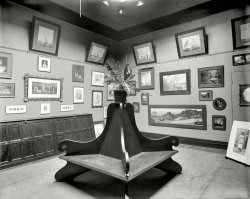
- Water Slide: 1900
- Sept. 15, 1900. Wyandotte, Michigan. "Launch of freighter Howard L. Shaw ." Thrilling prequel to this ... Posted by Dave - 02/27/2015 - 1:16pm -
![Water Slide: 1900 Sept. 15, 1900. Wyandotte, Michigan. "Launch of freighter Howard L. Shaw." Thrilling prequel to this image. 8x10 inch glass negative. View full size.
UnbelievableIn those days you could ride out a ship launch? Hold Tight! Dangerous...kids? Today the liability would never allow that!
Lookey Lou'sLooking at all the people in boats and on shore this must have passed as big entertainment in the day.
Grassy Island LighthouseI wonder if that's the Grassy Island Lighthouse behind the Howard L. Shaw. The view might be correct - the question where was that original lighthouse? From Here https://en.wikipedia.org/wiki/Grassy_Island it seems that the original island has been covered over with dredging material, so the shape is different.
This location on Google Maps seems to show the correct shape of a launching slip (or whatever it's called) pointing right at Grassy Island.
Sorted by rankLooks like the persons of stature are aboard the second ship, sipping punch; the hoi polloi are aboard the new boat, hanging on for dear life; and the great unwashed -- well, they're on shore, and about to get washed.
Prequel or... sequel? To me it looks like the aftermath of the linked photo.
[Tell us how you think that would work. First it's just sitting in the water. And then later, it lands with a giant splash in the exact same place? - Dave]
Now I see. I've only seen the kind of boat launches "on TV" where they slide straight out into the water, so I assumed that's what the previous image was... the boat before it slid into deeper water with a splash. Now I'm guessing the boat slid sideways into the water? I wondered what all those logs at the right of the previous photo were for.
Howard's EndIn 1969 the hull of the Howard L. Shaw was sunk off the coast of Toronto, to become part of the breakwater for the Ontario Place entertainment complex. She remains there today.
Mamajuda?Is that the now submerged Mamajuda Island and lighthouse in the background?
The first Bob-Lo boat.Passing in the background is the boat/ferry that first took passengers to the Bob-Lo Island Amusement Park from downtown Detroit. Built by the Detroit and Windsor Ferry Company in 1892 as the "Promise". A few years later to be replaced by the "Columbia" and "Ste. Claire". The Ste. Claire currently undergoing full restoration for a new job near New York.
TraditionalThey're still launching them this way in the Great Lakes. From last October, here's a video of the launch of the USS Detroit (LCS-7) in Marinette, WI. Still lots of gawkers, but no one riding it down the ramp.
Pictures of a lifetimeThe full history of the Howard L. Shaw here.
Background LighthouseThe lighthouse and island hasn't been around for a long time. That is the Mamajuda Island Light and for decades has only been marked by a buoy.
(The Gallery, Boats & Bridges, DPC)](https://www.shorpy.com/files/images/SHORPY-4a05235a.thumbnail.jpg)
- Erie Canal: 1910
- ... of the East to move West, cheaply. Ohio, Indiana, Michigan, Illinois and many other states went from wilderness frontiers to ... Posted by Dave - 09/29/2012 - 10:20am -
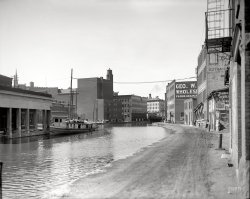
- Hotel Cadillac: 1914
- Detroit, Michigan, circa 1914. "Hotel Cadillac." Plus a variation on the 8:17 jeweler's ... Posted by Dave - 08/15/2012 - 3:06pm -
![Hotel Cadillac: 1914 Detroit, Michigan, circa 1914. "Hotel Cadillac." Plus a variation on the 8:17 jeweler's clock sign. 8x10 glass negative, Detroit Publishing Co. View full size.
Look-A-LikesThat rectangular structure rising above the Hotel Cadillac almost looks like the UN Building.
[I can understand why people might put one hyphen in "lookalike," and end up with "look-alike." But that second hyphen, so often added -- because two things look "a-like"? - Dave]
Window awningsI guess air conditioners killed window awnings. No need for open windows means there's no need to keep water out on a hot and rainy day, which was probably the main purpose of awnings. They really did change the character of a building; those stripes are awful.
[Then as now, awnings were for shade and heat control. - Dave]
A bit of updating to the old Hotel Cadillac - View Larger Map
LOLThe guy walking towards the camera holding the white package on the right side of the photo has his finger buried deep in his nose. Talk about a moment in time!
AwningsI absolutely love seeing the striped awnings on these buildings! So cosmopolitan.
(The Gallery, Cars, Trucks, Buses, Detroit Photos, DPC, Streetcars)](https://www.shorpy.com/files/images/4a25484a.thumbnail.jpg)
- Welcome to Petoskey: 1908
- Circa 1908. "Lake Street, Petoskey, Michigan." A bustling hub of commerce offering silk shawls, "kimonas" and "the ... Posted by Dave - 08/10/2012 - 12:04am -
![Welcome to Petoskey: 1908 Circa 1908. "Lake Street, Petoskey, Michigan." A bustling hub of commerce offering silk shawls, "kimonas" and "the place U-R looking for." As well as a nice arch. 8x10 inch glass negative, Detroit Publishing Company. View full size.
Lintel weightI believe that this is what was being referred to below. The lintel is the thing above the window.
It looks like a wayward stone decorative piece but from what? There is nothing above that it could have fallen from. It does look precarious.
[Thanks! I stand doubly-corrected! - tterrace]
What the?Something atop the lintel, middle window, second floor, left side of the photo.
[Looks like the kind of shelf often used in pre-refrigeration days to keep things, like milk, cool overnight. - tterrace]
The window to the right of that one, above it, not on the sill.
[Ah. Looks like a towel or other makeshift curtain, perhaps. - tterrace]
Right window, but up on top. Looks like a brick or chunk of concrete.
Heads up!Watch out for falling stone finials! Could this be why people have (voluntarily? ) had them removed from a lot of old buildings?
I see it now from the modern street view. It's the diagonal left to right strip and angle that made this somewhat of an optical illusion.
Paving?I'd really like to know if this bustling town has never had paving on its main drag, or if this shot was taken while the street was being repaved.
[It was the norm for small towns of the period. In my own home town, Larkspur, Calif., Magnolia Ave., even though it was part of the county's only north-south route, wasn't paved until 1913. - tterrace]
104 years laterView Larger Map
Mostly still here.From this pic, you can see at least three of the buildings on the right are still around.
Just a decorationThat precarious-looking window decoration appears to still be in place on current Google Streetview, so I guess it's not so precarious after all.
(PS. Hello everyone, I've been lurking for years. This is my first comment.)
FiniallyI think the decorative is not tilted, just shown from an odd angle (or I stared at it too long). It looks like a crest or shield with a horizontal band in the middle. The leg that appears to be supporting the "tilted" chunk, appears to have a symmetric mate. The other leg is barely visible, but you can see the scroll at its base.
HardwareThe hardware store was still in business in the early 1980s. I used to shop there regularly. They stocked things you could never find today at a big box. Now this street is all gift shops for upscale tourists.
Look at all those wires!Good thing we have come a long way with burying telephone and electrical wires! It looks so cluttered! Love this picture!
(The Gallery, DPC, Petoskey)](https://www.shorpy.com/files/images/SHORPY_4a22916a.thumbnail.jpg)
- Rooms With a View: 1912
- Detroit, Michigan, circa 1912. "Hotel Pontchartrain, Soldiers' and Sailors' Monument." ... Posted by Dave - 07/29/2012 - 6:09pm -
![Rooms With a View: 1912 Detroit, Michigan, circa 1912. "Hotel Pontchartrain, Soldiers' and Sailors' Monument." Along with the Flatiron building in New York, "The Pontch" was one of Detroit Publishing's favorite architectural subjects. View full size.
ShadesWhy the selective positioning of window shades on some windows and not others? More permanent residents or offices?
Given a choiceI think I would rather stay at the Metropole where all the windows have awnings.
Is this building still there?I've looked and can't find a thing about it! The only things I find are about a hotel in New Orleans, and one in Detroit which was built in the 1920s. I'm afraid this elegant structure is another of those that 20th century American mod freaks have destroyed. One of the things I loved best about Europe is that they rarely demolish anything. They build everything extremely well and then just keep using it. There are buildings that were there many years before Columbus that are still in use today. The insides are remodeled, but the exterior stays the same. When we were there, in the 80s, there was a lot of scrubbing of old buildings going on, to remove soot buildup from centuries of heating with coal. They came out as good as new! I don't know why we can't do that here!
[This short-lived hotel, whose main deficiency was a dearth of private bathrooms, was demolished in 1920 and replaced by a bank. Its history can be traced right here on Shorpy, in both the photo captions and the comments. - Dave]
(The Gallery, Detroit Photos, DPC)](https://www.shorpy.com/files/images/4a19784a.thumbnail.jpg)
- GLEW: 1906
- Ecorse, Michigan, circa 1906. "Great Lakes Engineering Works." 8x10 inch dry plate ... Morning Express
FREIGHTER HILL SOLD AGAIN
Detroit, Sept. 11, 1906 -- The wooden package freighter Charles B. Hill, ... Posted by Dave - 08/14/2012 - 2:11pm -
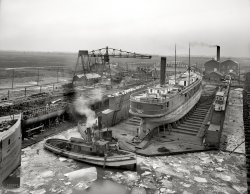
- Stand Back, Folks: 1917
- ... spell out "Electric Eagle Co." which was a brand made in Detroit, Michigan in 1915.
Also of note, District of Columbia license plate numbers ... Posted by Dave - 09/12/2011 - 12:10pm -
![Stand Back, Folks: 1917 Our third look at that circa 1917 car wreck at Massachusetts Avenue and 21st Street N.W. in Washington. As with so many of these old glass negatives, mold is colonizing the thicker parts of the emulsion. The result is an accident scene that looks like it's been dusted with flour. National Photo Company. View full size.
HonkWhile the horn is certainly cool, it is not a Klaxon. Klaxons are electric or hand powered. This could be a Rubes horn.
WrecksAll these early car accidents make me think surely there were carriage/wagon wrecks. Any pics of those?
[Not that I've seen. But there are plenty of newspaper accounts of "runaway teams," which seem to have been a major hazard. - Dave]
BottleWhat's that bottle for on the running board? If it were 50 years later or more, I'd say it's a fire extinguisher, or it's an NOS bottle and this heap piled up while draggin' fer pinks.
[It's acetylene gas for the headlights. - Dave]
The CarHas anyone identified the make of this auto? I didn't see a manufacturer's logo. It seems to be right-hand drive with controls outside the cab -- probably emergency brake. That great horn could be an add-on. With the worn and slightly tattered top it probably is dated sometime earlier than 1917.
[The hubs are embossed with what looks like the word "Eagle." Or maybe "circle." There's one more photo of this car left to post. - Dave]
Below, the 1907 New Eagle, a four-cylinder car made in England.
KlaxonThat horn is awesome.
EagleDave, I think you got it. Other details (radiator cap, horn) match nicely. Well done.
Eagle Electric Company?The radiator shape of the New Eagle and the car in the accident are vastly different. The radiator shape of the New Eagle is completely round at the top with no variation in the thickness of the grill surround.
The New Eagle that was made in Cheshire, England was only made from 1901 - 1907, and it seems very unlikely that any were imported into the U.S. There are also differences in the horn and side lights. A short history of these cars is here: http://www.3wheelers.com/eagle.html
Looking closely the hubcap looks like it might spell out "Electric Eagle Co." which was a brand made in Detroit, Michigan in 1915.
Also of note, District of Columbia license plate numbers 1 - 83 from 1907 - 1917 were issued to various automobile companies for demonstration purposes. Perhaps numbers 24 and 26 were out together on a demonstration ride.
Automobile1909 Columbia Model 29 Four-Passenger Toy Tonneau
(The Gallery, Cars, Trucks, Buses, D.C., Natl Photo)](https://www.shorpy.com/files/images/30980u.thumbnail.jpg)
- Liberty and Union: 1924
- Detroit circa 1924. "Michigan Soldiers' and Sailors' Monument, Cadillac Square." Also: "Don't Jay ... Posted by Dave - 09/23/2019 - 9:30pm -
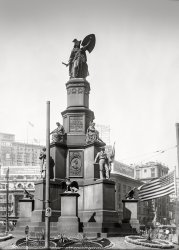
- National Tube Works: 1910
- ... but here we see a couple rather new looking Lake Shore and Michigan Southern hopper cars in the company of the Baltimore and Ohio units. ... belong to the Lake Shore & Michigan Railway which was mostly owned by Cornelius Vanderbilt and was ... Posted by Dave - 07/29/2012 - 1:32pm -
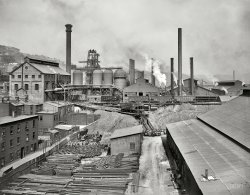
- Emergency: 1906
- ... public buildings, including the state capitals of Michigan, Texas and Colorado, city halls and courthouses all over the United ... Posted by Dave - 08/13/2012 - 10:07am -
![Emergency: 1906 Detroit circa 1906. "Harper Hospital." And a dubious-looking conveyance we trust isn't the ambulance. Detroit Publishing glass negative. View full size.
Grandly GothicThe seemingly endless variety of Harper Hospital's huge American Gothic style brick building and its dependencies sprawled over a four-acre campus, and housed one of the nation's most innovative teaching hospitals, staffed by Wayne State University's School of Medicine. The hospital's original wood buildings of the 1860s were replaced by this complex in the mid-1880s, which remained in use until it was demolished in 1970. The architect was Elijah E. Myers (1832-1909), a prolific and famously litigious designer of dozens of important public buildings, including the state capitals of Michigan, Texas and Colorado, city halls and courthouses all over the United States, and the old Brazilian Parliament building in Rio de Janeiro.
Hitching posts Like those faux tree hitching posts along the street. At least those stubs would keep the rope from slipping off as easily.
Also, is that a block of ice strapped to the vehicle's radiator? Maybe the thing was prone to overheating if it went faster than 5 miles an hour.
Free DeliveryThe vehicle appears to be a department store delivery van.
[Very plausible. - tterrace]
With Rue One's Heart is LadenThe architecture of this facility no doubt gave credence in the minds of more than a few that hospitals are places one goes to die.
(The Gallery, Cars, Trucks, Buses, Detroit Photos, DPC)](https://www.shorpy.com/files/images/SHORPY_4a13462a1.thumbnail.jpg)
- Shining Path: 1901
- ... 10:06pm. Our first visit to The Firs.
New Baltimore, Michigan, circa 1901. "The Firs. Under the firs." 8x10 inch dry plate glass ... Posted by Dave - 07/21/2012 - 9:39am -
![Shining Path: 1901 Originally posted 10/30/2010 - 10:06pm. Our first visit to The Firs.
New Baltimore, Michigan, circa 1901. "The Firs. Under the firs." 8x10 inch dry plate glass negative, Detroit Publishing Company. View full size.
Wonder where this was shot.I wonder where this was shot. I grew up in New Baltimore and have family going back over a hundred years there. Nearly all of the old woods are gone now. I wonder if these ladies were relatives. It would be nice to think so.
[The Firs was the home of the Hatheway family. There was a large house and a barn. The New Baltimore Historical Society puts it at the corner of Washington and Cemetery roads. - Dave]
In hidingI didn't even notice the ladies at first! Sppppppooooooooky.
Scary winnerThis is probably the scariest picture I have seen yet on Shorpy!
Don't go toward the Light!You're not trapping me in your haunted parallel dimension, ghost women!
The BirdsThis looks like it could be a scene from a Hitchcock movie.
Boo!An appropriate photo to post the day before Halloween. "Walk toward the light."
Be cautious over the next couple of weeks!The face of the woman on the far right suggests that she recently viewed the "Ring" film clip. It's a good thing televisions weren't around back then, or she might be receiving an unwanted visit from an entity crawling out of a well.
Ooo, ooooo, witchy womenWhen shall we three meet again?
In thunder, lightning, or in rain?
(I say, could either of you lovelies spare a little eye of newt?)
I can just imagine it.After the fourth or fifth take, the Photographer smashing his Camera, busting the Tripod over his knee, walking off muttering something about "standing still just for three lousy seconds".
(The Gallery, DPC)](https://www.shorpy.com/files/images/4a20404a.thumbnail.jpg)
- Bombs Away: 1929
- ... the Packard Proving Grounds in Utica (now Shelby Township) Michigan. You can read the detailed explanation (published in 1930 by Charles ... Posted by Dave - 06/10/2014 - 6:46am -
![Bombs Away: 1929 1929. Washington, D.C., or vicinity. "NO CAPTION [Man in airplane]." Next-door neighbor to this image in the Harris & Ewing negative series. View full size.
The doorsAnother great-detail shot from Shorpy.
I like the strap window risers (similar to Model T trucks) and the little inside door latches/locks mounted above the inside door handles
A lead fishTobacconist has nailed it. This is not the C.F. Jenkins invention described in the 1929 newspaper clipping; it is however, an earlier system described exactly in patent US1893287 which Jenkins filed Aug. 23, 1929. The second paragraph begins "Heretofore it has been customary in airplane-radio equipment to suspend a wire under the plane with a lead weight, 'a lead fish' attached to the free end thereof to hold it steady, and as nearly vertical as possible." It is possible that the fellow pictured is an associate of Jenkins' conducting experiments with this "prior art" system. Jenkins invention was the subject of an earlier picture here at Shorpy.
Aircraft identityThe aircraft in the photo is a Fairchild FC-2. Production began in 1927.
Can You Hear Me Now???While Jenkins was working on this contraption, the Packard Motor Car Company had already solved the problem with radio static in an airplane – they designed, built and flew a diesel radial engine for an airplane. Because diesel engines do not have spark plugs, wires and other electrical interference items, The pilot can now communicate static free.
It was done on June 3, 1929 over the skies of the Packard Proving Grounds in Utica (now Shelby Township) Michigan. You can read the detailed explanation (published in 1930 by Charles H. Vincent, VP and Director of the Packard Proving Grounds. You can see the report here.
On June 1, 2014 the PPG Amateur Radio Club held a special event to commemorate the 85th anniversary of this special event.
On 28 May 1931, a Bellanca CH-300 fitted with a DR-980 diesel engine, piloted by Walter Edwin Lees and Frederic Brossy, set a record for staying aloft for 84 hours and 32 minutes without being refueled. This record was not broken until 55 years (1986) later by the Rutan Voyager. See this.
Ask the Man Who Owns One
Advanced technologyA nice look at the engine control levers in the cockpit -- throttle, ignition timing, and mixture.
In for a pennyAround this time experiments were being conducted with receive-only radios in patrol cars. The Detroit Police Department had a system in place since April 1928. They used higher frequencies than did commercial broadcast radio.
So why not radio receivers in airplanes? That little bomb-shaped device could very well be a streamlined weight for lowering an antenna wire.
Or perhaps this from the September 28, 1929 issue of the Appleton, Wisconsin Post-Crescent:
BoomerWhat a darling baby bomb!
InstrumentsIt's a shame we can't quite see what the rear seat instruments indicate or any labels on knob and panel...
But there is a clinometer visible, one with a very small range, I think 10 degrees either way. Whatever was happening, the instrument guy wanted the plane to be level.
$.02The aluminum reel located on the floor of the plane, I going to say, is connected to that weight that looks like a miniature bomb under the fuselage. The gentleman looks to be seated in front of receiving equipment. This equipment possibly could've been used to receive a signal from the equipment in the earlier photo.
We may be looking at an early attempt at an direction finding experiment. Or, again referring to the earlier picture, that metal framing in front of the operator may have been a shortwave, for the time, frequency director dish and they had been doing radio glide slope experiments. With all those batteries, much more than would ever be needed for a battery radio receiver, it looks more like a transmitter with a fairly high B+ voltage. But what's not present are the transmitter tubes of the era.
Now Try Not To MoveThis looks like one of those early 20th Century photo ops. Sort of like those an itinerate photographer would take of a child on a pony.
Magnetometer?Suspended from a retractable wire, with associated electronics in the plane, the small bomb-like instrument on the wire under the airplane is very similar to the larger object in the background of the "Bright Star" photo.
Perhaps the strange sheet metal assembly in the "Bright Star" photo could be some kind of magnetic field director, possibly part of an experiment in secure non-radio battlefield communications methods. A large electromagnet would need a lot of DC power and the big battery bank could supply that, while the other equipment on the table could be a means of modulating the magnetic field to transmit information.
Who knows? A lot of ideas were tried out in the early days of electronics.
Trailing aerialswere still in use in the Viet Nam conflict, C-130's had massive trailing aerials many kilometers long, they flew in circles so the aerial would be almost vertical.
(Technology, The Gallery, Aviation, D.C., Harris + Ewing)](https://www.shorpy.com/files/images/SHORPY-35252a.thumbnail.jpg)
- Peeking Woman: 1901
- New Baltimore, Michigan, circa 1901. "The Firs -- upper hall." Our second look inside the ... Posted by Dave - 08/13/2012 - 6:57pm -
![Peeking Woman: 1901 New Baltimore, Michigan, circa 1901. "The Firs -- upper hall." Our second look inside the Hatheway residence. Note the cloud of flash powder emanating from behind the stairs. 8x10 glass negative, Detroit Publishing Co. View full size.
The FirsSupposedly, the house was haunted and this photo is only adding to that. Rumor has it that Mabel Hatheway, daughter of the home's builder Gilbert Hatheway, died at age 20 in the house of mysterious circumstances. It was said that she "fell" down the stairs and broke her neck. There's also a rumor that she was buried in a glass coffin but who knows if that's true.
September 6, 1901There's an American flag draped over the portrait hanging in the hall. I wonder if this photo was taken shortly after the assassination of President McKinley.
Poor dogLooks like when Rover died they made a rug out of him.
Haunted!But, but, there was no one in that room!!
Cue Twilight Zone music.
As a little kid.This place would be a constant source of fear for me as a kid.
1. Going up those stairs was certain death, as that is where the creepy mean guy lived.
2. Someone is bound to reach out and grab you into that first door on the left.
3. The next door down the hall, I'm sure someone is peeking out the crack between the door and the frame.
4. There is definitely a mad man hiding in the corner behind the open door ready to pounce.
5. Inside the far room, I can see the shadow of an axe murderer on the floor. Waiting. Waiting.
6. Down the stairs, worse than going up.
No way I could run fast enough to get to that door at the far end to escape.
Flash Powder?You don't know ectoplasm when you see it? And that's a werewolf-skin rug.
The flag is blocking glareI think the flag was put there to block the glare from the flash powder ignited behind the stairs.
Remote Flash?It looks like there were two flashes for this shot. One attached to the camera and the other behind the staircase. Looking at the shadows caused by the flashes seem to show this.
[You're right, although in this case both the one at the camera and the "remote" would have been guys holding the magnesium flash brackets and setting the powder off manually. - tterrace]
Flash SyncI've often wondered how the old timers obtained such well exposed images when the distance from the camera was so great. Seeing the magnesium cloud suggests there were assistants as needed and the photographer opened the lens, gave a signal and they all set off the flash powder then he closed the lens.
What's in the bottle?Wonder what's in that mysterious uncorked jar on the sideboard?
[Close-up, it doesn't look uncorked. I want to say the label reads "Furni[ture Polish] - tterrace]
That bottlemight contain Furniture Polish, or given the shape and style of the bottle and the fact that it was used in the period as an over-the-counter disinfectant, insecticide, and home remedy, it could contain Formaldehyde (or Formalin). Using the LoC original with contrast adjustments, my tired old eyes can't make a definitive case for the label reading either "Furni" or "Forma" (both are plausible), and the line below remains a tantalizing mystery. If only that bottle had been turned a few more degrees toward the camera.
[There certainly are similarities to this one. - tterrace]
(The Gallery, DPC)](https://www.shorpy.com/files/images/SHORPY_4a20401a.thumbnail.jpg)
- Western Star: 1903
- October 3, 1903. Wyandotte, Michigan. "Launch of the Western Star ." 8x10 inch dry plate glass negative, ... Posted by Dave - 07/20/2012 - 7:17pm -
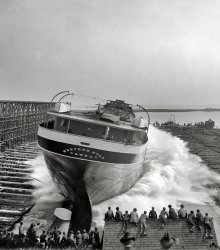
- Industrial Tableau: 1900
- ...
The other end of the trail We saw the Marquette, Michigan docks where they load the boats with ore a few years ago on Shorpy. ... Posted by Dave - 07/11/2016 - 10:11pm -
